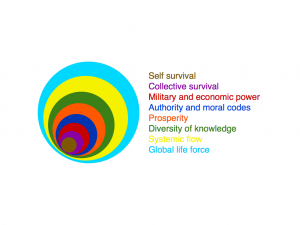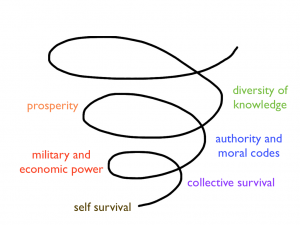When looking ahead at our expansive, evolutionary future, there is a distinction between specific and general destinations. We do not know specifically where we are headed, but the general destination is known: survive and improve. But destination is not only way out in the future; we choose immediate, short term destinations in our day-to-day lives. The closer these choices are to the present, the more specific they seem to become.
Let’s touch base with the scenario introduced in Cities are as good as we allow them, where I dream of crossing the Rocky Mountains to reach the West Coast of North America to surf the ocean waves. I have a long-term destination in mind: to get to the coast. My short term decisions are more specific: I need to get fit, I need to buy the equipment I need, I need to research how I will cross the mountains, and I need to start saving money for this trek. I know nothing about surfing, so I will not know where exactly I will surf until I get to the coast and check in with locals about a good place to go.
My short-term decisions are not disconnected from the longer-term purpose: surfing. My short-term decisions are not fixing what is wrong with my current state, but rather focused on what I want to come to pass. Each small decision has a purpose that is connected to the larger purpose. Each large purpose informs the purposes of smaller, more immediate decisions.
So there are scales of purpose. As we contemplate the purpose of each piece of destination, it is informed by the smaller and larger decisions. In yesterday’s post, I resurfaced my graphic of city purposes as a spiral, using Spiral Dynamics. Each level of purpose also transcends the previous purposes and becomes the foundation for a larger, more expansive purpose. There are scales of city purposes just as city systems are scaled (recall Marilyn Hamilton’s holarchy of city systems in Figure A).
The destinations we aim for, and the purposes of those destinations, either for the self or the city, are nested as well (Figure B).

These are the same purposes articulated in yesterday’s Spiral, but with two additional levels (systemic flow and global life force), the additional layers of purpose now emerging. (For more on Spiral Dynamics, here is a primer). Our decisions today, whether in the short- or long-term are crafting these new layers of purpose. We are, in the relationship between self, other and the places we create, co-creating the emerging next purposes and destinations. As Steve McIntosh points out, the overall purpose in evolution itself is still evolving (Evolution’s Purpose).
Back to my journey across the mountains. Each step I take in the short term is a building block to the destination I have in mind. As I make my choices for food and lodging on my journey through the mountains to get to the coast, the resources I will have when I get there are impacted. I have to ensure I have both the bodily sustenance to physically perform when I get there and have enough money to pay my way. My short-term decisions are connected to both a short-term destination and a longer-term destination. Both the short-term and longer-term destinations are of value. The big destination can not be reached without the small steps, each with their own short-term purpose. The small steps we make are the fundamental steps toward the future that is calling.
Of course, when I get ‘there,’ I may find that the ‘there’ is not what I thought. When I reach the Coast and try surfing, I find that it is not surfing that was calling me, but rather floating on the water and exploring the shoreline in a kayak. My destination moved. Or rather, it emerged. I knew roughly where I wanted to go, made the effort to get there, and learned that my destination was a direction, not the destination itself. The direction was to explore the water; I just didn’t know specifically how. There was direction in the destination, just not as I conjured it setting out on my journey. A reminder that farther-off destinations are general, not specific.
The pattern appears to be that the more immediate the purpose the more specific the destination. The more ‘expansive’ the purpose, the destination becomes a direction: improvement.
How are your short-term destinations connected to the bigger destinations you feel in your soul?
